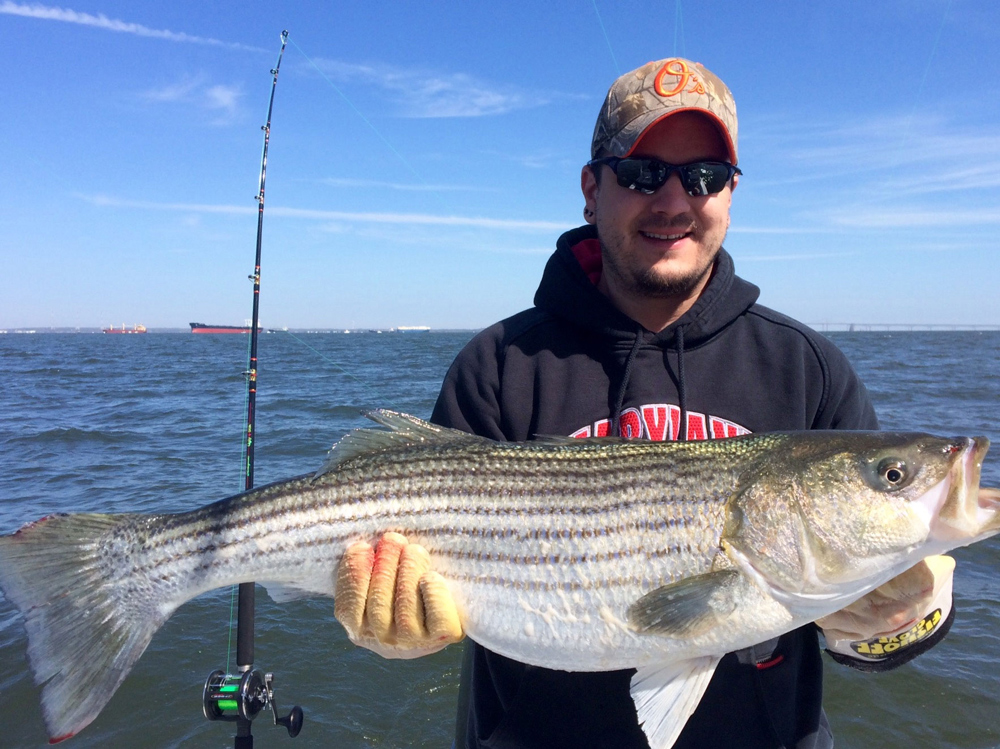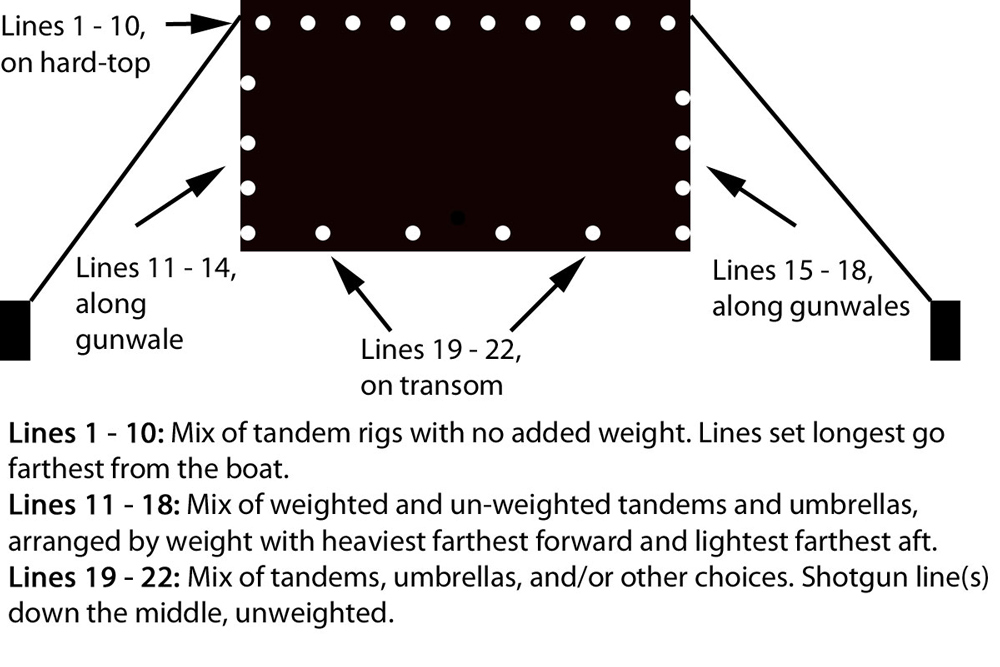Some people enjoy light tackle jigging for stripers and others like to try chumming, but as a general rule of thumb, most spring trophy seasons trolling will be the number-one most effective way to catch the highest number of fish. Other methods may provide more success on this day or that, and may be more rewarding to some anglers. But if you want to fill the box as quickly as possible and as often as possible, trolling is the way to do it. If, that is, you know how the pros go about setting a spring trophy striper trolling spread. Before we get into the details, here's a look at some of the tackle it's critical to know about.
Maximizing the Trolling Spread
A key to being a successful troller has to do with maximizing your spread. One of the main reasons why trolling is so effective at this time of year is that the fish aren’t schooled up, but are scattered throughout the open bay as they migrate out of it. By straining the water with dozens of lures, you have a high probability that sooner or later, one of those lures will happen to intersect with a fish. Hence the nickname “collision fishing”.

Charter captains will often pull a spread consisting of up to two dozen or so rods, many with multi-lure rigs, resulting in a huge number of hooked baits in the water. “Sometimes I need to catch A LOT of fish,” says Capt. Drew Payne, of Worm Fishing Charters in Chesapeake Beach, MD. “More lines equals more lures in the water equals an increase in your chances.”
How’s it possible to run this many lines in the first place? To start with, you need a lot of rodholders on your boat. Holders lining the gunwales, holders lining the transom, and holders lining the hard top or arch. Second, you need to utilize planer boards. Failing to do so will greatly reduce your likelihood of filling the box. Even from a 20-something center console, using planer boards plenty of fishermen manage to set out 12 or 14 rods. And beyond the numbers game, planer lines just seem to catch more fish.
“I get asked constantly, if you only had six rods, where would you put them?” says charter captain Greg Buckner, of Miss Susie Charters, based out of Solomons and Deale. “My answer is always the same: three rods off each planer board.”
Anglers new to this game should not just go out and buy a set of planer boards, deploy them on their first trip of the season, and expect everything to go just honky-dory. While using them is fairly straightforward, they also introduce a lot of potential for disaster. If a board trailing five or six lines flips, the tangle is monumental—it can literally shut you down for hours. Maneuvering through the crowd with planer boards in tow can also be a bit of a challenge. Rather than jumping right into this game, it’s best to go fishing a few times on a charter boat, to learn the ropes.
“Often times, once anglers buy a boat they no longer see the need to book a charter on the Chesapeake Bay,” Buckner explains. “This really hurts the learning curve, because the wealth of information an angler can learn from a charter is worth much more than the price of the charter. If you pay close attention while onboard, you’ll be amazed at how helpful it is seeing things done first hand by professionals.”
Once you have your planer boards and are ready to fish, you’ll set out one board to either side and then cleat or tie off the line the boards are attached to. Swivels, carabiner clips, or shower-curtain clips get snapped around the planer board line, and are then attached to your fishing line via a release clip or rubber-band. But first, those lines need to be set back to the desired length. Savvy anglers mix up the lengths until they find out what’s working best; set the first lure back at 100’, the next at 80’, and so on. Make sure some lines are as short as 50’ back, because for whatever reason, sometimes those short ones do all the catching. Once set back, the fishing line gets attached to the clip. Let out line from your reel, and tension will draw the line away from your boat and towards the board. Once the line’s all the way out, set the rod in the farthest outboard holder and move on to the next one. Using this method, you can “stack” multiple lines on a single planer board line. When a fish grabs the lure, the clip pops open or the rubber-band breaks, the fishing line is released from the board line, and the fight is on. Usually. Every now and again a too-tight clip or a surprisingly rugged rubber-band stays attached, and you’ll need to jerk the rod a few times to get the line to pop free.

With the board lines set, it’s time to work on the boat rods. Most anglers will set some deeper lines with heavier rigs from the boat rods, since heavy rigs can pop the clips or break the rubber bands if you attempt to deploy them on a planer board line. And while it’s true that most of the time the majority of the spring trophy fish will come from the top 15’ or 20’ or the water column, it’s always a good move to have some lines set deeper. Those slow days when the fish just don’t seem willing to bite are often saved by the deep lines.
Set the boat rods back at staggered lengths, just as you did with the planer board lines, to cover as much water as possible. Similarly, add weight to various rods to cover different depths. In the case of tandem rigs, varying the weight is easy—just choose different size lures to get the rigs down to different depths. But in other cases, you’ll want to clip some lead on the line. If the rods on the corners of the transom are running umbrellas 75’ back with no weight, for example, on the next two rods inboard of them add eight or 10 ounces. Or, if your boat has the capacity, use downriggers to set a pair of the umbrellas down to 30’ or so. You can also cleat off a length of 300-lb. test on the transom and drop down a downrigger ball to get a line or two deep. Remember—these lines generally won’t catch as many fish through the course of the season, but those deep lines are the ones that save the day when the bite is off.
The Best Striped Bass Trolling Lures
Just what will you be running from all these lines? A mix of tandem rigs and umbrellas is the standard fare. Some anglers add in daisy chains, some put a Mojo or two into the spread, and some also utilize a lipped swimming plug. Most professionals agree that tandems and umbrellas are the most effective way to go, with some also favoring a single lipped swimming plug or a big bunker spoon set straight back from the middle of the boat in the “shotgun” position. (Alltackle.com has a number of pre-rigged striped bass trolling packages and lure kits).
“Use only nine and 12-inch shad on your baits when fishing for trophy stripers,” advises Capt. Buckner. “Elephants do eat peanuts, but put a big bale of straw and a single peanut in front of a hungry elephant, and see which he goes for.”
It’s also worth noting that Buckner isn’t a big fan of some of the more traditional lures that some old-timers still like to pull. “While there’s no doubt big spoons and bucktails have caught their share of fish,” he says, “parachutes tied with synthetic nylon hair produce a larger, more life-like presentation. These parachutes rigged with plastic shad are deadly effective, and easily account for 99-percent of the trophy stripers caught by charter boats on the Maryland Chesapeake Bay.”
Capt. Payne favors Spankin Stripers lures, in specific. “They come in a handful of colors and sizes and I catch a lot of fish on them,” he said. “Plus, the eyes don’t fall out. I like the larger ones for spring, nine ounce I believe.”

Color choices will vary from season to season, but as a general rule of thumb chartreuse and white prove most effective. Last year metallic blue was also quite hot, and at times it seemed like “ruby lip” heads (with the red-painted notch at the top) out-caught regular bullet-heads.
For small-boat anglers with a limited number of rods, it’s particularly important to try a wide variety of lures and colors and adjust your spread rapidly according to the bites. If a white parachute with a chartreuse shad gets the first strike of the day, immediately swap out something else for another white/chartreuse parachute to make sure you have multiple offerings of this pattern in the spread. And if it gets hit again, change over two or three more.
While we’ve seen a rise in the popularity of simple shad-body lures (as compared to parachutes) in the past few years, also remember that using a parachute gives you the added advantage of being able to alter the lure’s contrast a bit. You can mix a white tail with a chartreuse parachute, or vise-versa, and while most of the time this doesn’t seem to matter much, on some days that mix-match is unquestionably more effective than a single-colored bait. In extremely low-light conditions you can swap that tail out for a purple or a black, and you might be surprised at how effective this can be. And Capt. Buckner also advises anglers not to be afraid to mix and match colors, noting that a mixed-color parachute often out-catches one with matching colors.
See our Live With Lenny episode on spring trolling tactics:
So: are you ready to fill that fishbox? With a set of planer boards and a thick selection of tandems and umbrellas, you’ve got everything you need. If, that is, your boat has rod holders. Lots and lots of rodholders.
If you'd rather fish with light tackle but still want to give trolling a shot, be sure to check out Crash Course: Light Tackle Trolling for Trophy Stripers.